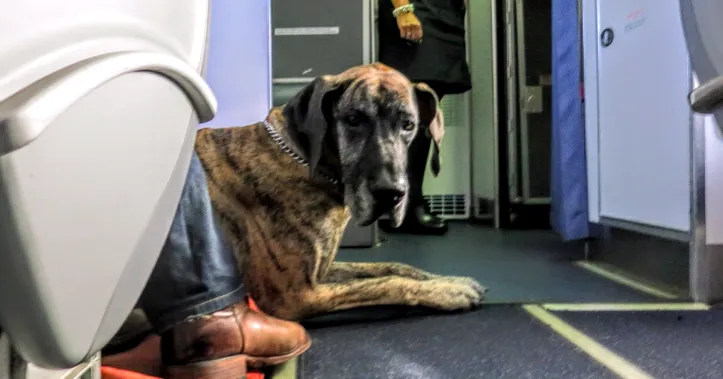A Comprehensive Guide to Flying with Your Emotional Support Dog
Flying with your emotional support dog (ESA) can be a hassle-free process if you follow the proper guidelines. As an aviation professional with experience handling hundreds of pets on flights, here are answers to all your questions about traveling by air with an ESA.
Do I Need Documentation for My ESA?
Yes, you must have official documentation for your ESA from a licensed mental health professional. This letter should state that you have a disability as defined by the Fair Housing Act or Air Carrier Access Act and that your ESA provides emotional support to alleviate symptoms of that disability. Airlines may ask to see this letter, so always keep it with you during travel.
What Forms of ID Does My ESA Need?
While an ESA is not required to have breed or vaccination records like a regular pet, it is a good idea to bring vaccination records in case an airline asks. Most importantly, you should have your ESA microchipped in case it gets lost during the trip. A collar and ID tag with your contact info attached to your ESA’s collar can also help identification if needed.
How Do I Prepare My ESA for the Flight?
To ensure a stress-free flight for both you and your ESA, consider the following tips:
- Practice taking your ESA for car rides and to busy public areas to get it accustomed to traveling and crowds before flying.
- Give your ESA calming supplements or anxiety medication as recommended by your vet if it has any flight anxiety issues.
- Bring your ESA’s favorite toys, treats or worn article of your clothing in its crate for comfort.
Having a well-socialized, relaxed ESA will make the airport experience much smoother.
What Are the Rules for Flying with an ESA?
Most major airlines allow one ESA per passenger in the cabin provided it fits under the seat or at your feet. The ESA must remain harnessed, leashed or otherwise under control at all times. It is prohibited to allow the ESA to sit on seats or walk around freely in the cabin or lavatory. For international flights, check specific rules for the destination country regarding ESA import regulations.

How Should I Prepare for Securityscreening with My ESA?
When going through security, inform TSA officers you are traveling with an ESA. They may require you to remove your ESA from its carrier for an additional screening. Be prepared to show documentation for your ESA if asked. Stay calm and controlled with your ESA to avoid delays. Consider arriving extra early as security screening with animals takes additional time.
What Are the Best Practices When Flying with an ESA?
To make the flying experience pleasant for all, follow these best practices:
- Keep your ESA properly groomed, wearing an identifying vest or leash for easy recognition.
- Bring a portable plastic mat, potty pads or newspapers in case of accidents. Clean up promptly to avoid issues.
- Come prepared with a crate, carrier or well-trained ESA secured by your feet or under the seat at all times for safety during takeoff, landing and turbulence.
Being considerate of others around you goes a long way in negotiating airport crowds and flying comfortably with your ESA.
From my experience handling animals during red-eye flights, the key is keeping your ESA well-exercised before the trip to ensure it sleeps through the night. A worn article of clothing rubbed on your ESA’s bed also helps calm pups during travel.
What If Issues Arise During the Flight?
In rare cases, an ESA may act out due to stress or health issues like motion sickness. Some things to watch out for include:
– Excessive barking, crying or disruptive behavior: Calm your ESA with treats and settle it quickly to avoid disturbance.

– Accidents in the plane: Thoroughly clean any messes right away with disinfecting wipes. Aircrew should be informed in such cases.
– Signs of illness: If your ESA vomits, has diarrhea or shows other sickness symptoms, alert a flight attendant immediately for potential isolation in the lavatory or other response depending on severity.
Being equipped to handle minor issues yourself shows responsibility and prevents larger disturbances. Uncontrollable ESA behavior may lead to being denied for future flights, so compliance is key.
What if I Need to Change Flights or Take Multiple Connecting Flights?
When booking multiple flight segments, allow ample time between connecting flights in case of delays. Reconfirm your ESA travel reservations at each stopover due to occasional gate changes. Be prepared for potential issues like checked-baggage fees since ESAs must remain in-cabin. When rescheduling flights, notify airlines promptly about traveling with an ESA due to aircraft type limitations. Proactive communication ensures seamless multi-city trips.
Overall, keeping your ESA properly documented and controlled goes a long way in guaranteeing its acceptance on all planned flights. Most issues arise due to lack of preparation rather than ESA regulations themselves. With the right approach, you can look forward to many stress-free flying experiences with your furry companion by your side. Let me know if you have any other ESA travel questions!
Resources for Flying with an ESA
For more tips and updates on ESA flying rules, check out these reliable sources:

- ESADogs.com: Comprehensive guide on documentation, training and flying rights for emotional support animals
- ASupportAnimal.com: Information on how to get an ESA letter and airline accommodation letters
- TSA.gov: Transportation Security Administration guidelines on support animals in airports
You can also join online ESA owner communities on Facebook and Reddit for advice and experiences from fellow travelers. Wishing you many happy adventures with your furry co-pilot!
ESA Dog Air Travel Information
| Requirement | Details |
|---|---|
| ESA Letter | Must have a valid ESA letter from a licensed mental health professional dated within 1 year |
| Carrier Policies | Check specifics for your airline – most major carriers allow ESA in cabin with letter |
| ESA Training | Dog should be well-trained in basic obedience, house trained, and able to remain calm during travel |
| Vaccinations | ESA must have accurate vaccination records including rabies vaccination |
| Collar/Harness | Always use collar or harness to identify dog as an ESA |
| Kennel | Not required to be kept in kennel under seat during flight with ESA letter |
FAQ
-
Do I need to reserve a spot for my ESA on the plane?
Generally speaking, you don’t have to make a reservation for an emotional support animal on domestic flights within the United States. As long as you have the proper documentation from your mental health professional and your pet behaves nicely, they should be allowed to accompany you for free in the cabin. At the same time, it’s always a good idea to contact the airline ahead of time to check their specific policies.
-
What paperwork do I need for my ESA?
The main documentation required is a letter from your licensed mental health professional — basically just a note saying that you have a disability and your pet provides emotional support. Make sure this letter is dated within one year of your flight. You’ll also need to keep your pet under control and ensure they don’t bother other passengers. Apart from that, most airlines don’t require additional forms or health certificates for emotional support animals.
-
Where can my ESA sit on the plane?
ESAs are allowed to accompany passengers in the cabin rather than being stowed in the cargo hold like regular pets. However, the animal must remain at your feet or on your lap for the entire flight. Sort of like a friend you bring along! They aren’t permitted to have their own separate seat, no matter how cute your puppy gives you the sad eyes. The good news is your furry friend can offer emotional support under the seat in front of you.
-
What size or breed restrictions apply?
Most airlines limit emotional support animals to dogs and cats that are small enough to fit safely under the seat. I guess bigger breaded folks like Great Danes or Mastiffs might find it cramped! Occasionally you’ll see folks traveling with tiny horses or pot-bellied pigs trying to pass them off as ESAs. But those kinds of larger animals are almost never allowed in the cabin for obvious reasons. Stick with dogs or cats under 20 pounds and you shouldn’t encounter any issues regarding size.
-
Can an emotional support animal sit on my lap the whole flight?
Holding a pet on your lap for a multi-hour flight can get pretty uncomfortable, not to mention stressful for the animal too! While ESAs are permitted to sit in your lap during takeoff and landing for extra emotional support, it’s advisable to have them sit nicely at your feet for most of the journey. This allows you both to move around a bit to avoid falling asleep on each other. Perhaps bring a cozy pet bed or towel as well to keep them content under the seat. But is it worth sacrificing your lap blood circulation? You decide!

-
What if my ESA misbehaves on the plane?
Even very well-trained pets can get anxious in new environments like an airplane cabin. If your emotional support dog starts barking excessively or has an accident, you may be asked to put them in a carrier under the seat for the rest of the flight. Airlines have the right to refuse future travel for pets that cause problems and disrupt other passengers. So make sure to prepare your furry friend with practice trips, training and calming aids like thunder shirts. A misbehaving ESA isn’t doing you or them any favors! It pays to have a backup plan in case they get freaked out.
-
Will my ESA be allowed in the airport terminal?
As long as the animal is properly harnessed/leashed and under control, emotional support animals are permitted to accompany owners inside airports as needed for mental health purposes. Gone are the days of having to leave therapy dogs tied up outside the security gates! However, there may be some limits in certain areas of the airport for sanitation or safety issues. It never hurts to double check rules with your airline before your journey. But overall, ESAs tend to get more access privileges than regular pets when traveling by plane these days. Amazing how far we’ve come!
